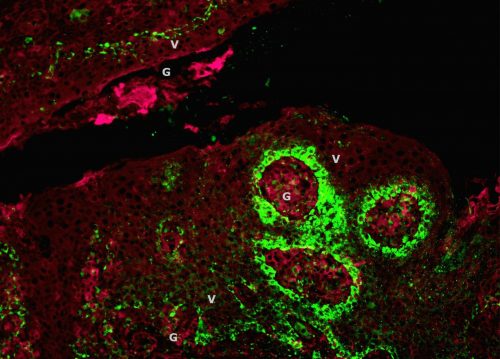Source: www.genengnews.com
Author: staff

Human papilloma virus (HPV) encased in biofilms inside tonsil crypts (pictured) may explain why the roughly 5% of HPV-infected people who develop cancer of the mouth or throat are not protected by their immune systems. Tonsil crypts with HPV are shown in green; epithelial and biofilm layers are shown in red. [Katherine Rieth. M.D.]
Researchers from University of Rochester Medical Center (URMC) found HPV encased in biofilms inside tonsil crypts, where HPV-related head and neck cancers often originate. HPV is shed from the tonsil during an active infection and gets trapped in the biofilm, where it may be protected from immune attack.
In the crypts, the virus likely lays in wait for an opportunity to reinstate infection or invade the tonsil tissue to develop cancer.
“The virus gains access to the basal layer of stratified squamous epithelium through structural breaks in the stratified epithelial superstructure,” the investigators reported in the study. “Tonsillar crypt reticulated epithelium itself has been shown to contain numerous small blood vessels and has a discontinuous basement membrane, which may facilitate this infection and reinfection process.”
The URMC researchers said their finding could help prevent oropharyngeal cancers that form on the tonsils and tongue—and may explain why the roughly 5% of HPV-infected people who develop cancer of the mouth or throat are not protected by their immune systems.
HPV 16 and 18, high-risk strains that are known to cause cervical cancer, also cause head and neck cancers. While verified tests can detect HPV in people before they develop cervical cancer, that’s not the case with head and neck cancers, which according to a 2016 study are expected to outnumber cervical cancer cases by 2020.
“Far-Reaching Implications”
“Given the lack of universal HPV immunization and the potential for the virus to evade the immune system, even in individuals with detectable HPV in their blood, our findings could have far-reaching implications for identifying people at risk of developing HPV-related head and neck cancers and ultimately preventing them,” Matthew Miller, M.D., associate professor of otolaryngology and neurosurgery at URMC, said in a statement.
Dr. Miller and six colleagues detailed their findings in “Prevalence of High-Risk Human Papillomavirus in Tonsil Tissue in Healthy Adults and Colocalization in Biofilm of Tonsillar Crypts,” published online January 25 in JAMA Otolaryngology-Head & Neck Surgery, and announced by URMC today. The study’s corresponding author is Katherine Reith, M.D., an otolaryngology resident at URMC.
The researchers carried out a retrospective, cross-sectional study using samples obtained from tonsils archived at a university hospital following elective nononcologic tonsillectomy from 2012 to 2015. The samples consisted of formalin-fixed, paraffin-embedded samples of tumor-free tonsil tissue from 102 adults who had elective tonsillectomies and were between ages 20 and 39. More than half the patients (55, or 53.9%) were female.
Five of the samples contained HPV and four contained HPV 16 and 18. In every case, HPV was found in tonsil crypts biofilms.
HPV status was assessed by polymerase chain reaction (PCR), and high-risk subtypes 16 and 18 were assessed with quantitative PCR assay. Samples that demonstrated presence of HPV were then analyzed by in situ hybridization to localize the viral capsid protein.
These samples were then stained with concanavalin A to establish biofilm presence and morphology and with 4′,6-diamidino-2-phenylindole (DAPI) to visualize location of the virus in relation to cell nuclei. Data was assembled for aggregate analysis to colocalize HPV in the biofilm of the tonsillar crypts, the URMC researchers reported.
The research team plans to develop topical antimicrobials designed to disrupt the biofilm and allow the immune system to clear the virus—part of their investigation of potential screening tools, such as an oral rinse, to detect HPV in the mouth and throat.

Leave A Comment
You must be logged in to post a comment.